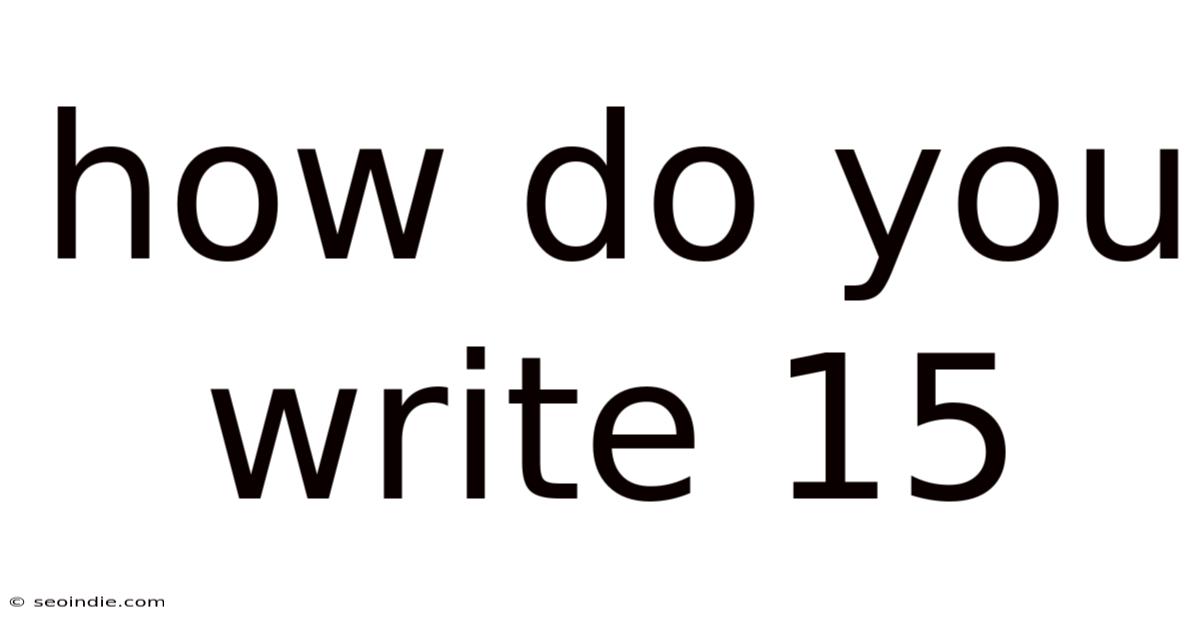How Do You Write 15
seoindie
Sep 10, 2025 · 4 min read

Table of Contents
How Do You Write 15? A Deep Dive into Number Representation and Writing Systems
The seemingly simple question, "How do you write 15?" opens a fascinating window into the world of mathematics, linguistics, and cultural history. While the answer might seem obvious to most – we simply write "15" – the process and the underlying principles are far more complex than they initially appear. This article explores various ways to represent the number fifteen, delving into its numerical representation in different number systems, its written expression across languages, and the historical evolution of these representations.
Understanding the Concept of "Fifteen"
Before we delve into the specifics of writing "15," let's clarify the concept itself. Fifteen is a natural number, specifically a composite number because it's divisible by numbers other than one and itself (3 and 5). It's also an odd number, not divisible by two. Understanding these fundamental mathematical properties is crucial to appreciating the various ways it can be expressed.
Writing "Fifteen" in the Decimal System
The most common way to write fifteen is using the decimal system (base-10), which we use daily. The decimal system uses ten digits (0-9) to represent all numbers. Fifteen, in this system, is written as 15. The "1" represents one ten, and the "5" represents five ones. This positional notation is a significant advancement in number representation, allowing us to express arbitrarily large numbers with a limited set of symbols.
Representing Fifteen in Other Number Systems
The decimal system is not the only system for representing numbers. Let's explore other bases:
-
Binary (Base-2): The binary system uses only two digits, 0 and 1. Computers use binary because it's easy to represent with electronic switches (on/off). Fifteen in binary is 1111. Each digit represents a power of 2 (from right to left: 2⁰, 2¹, 2², 2³). 12³ + 12² + 12¹ + 12⁰ = 8 + 4 + 2 + 1 = 15.
-
Octal (Base-8): The octal system uses eight digits (0-7). Fifteen in octal is 17. This translates to 18¹ + 78⁰ = 8 + 7 = 15.
-
Hexadecimal (Base-16): The hexadecimal system uses sixteen digits (0-9 and A-F, where A=10, B=11, C=12, D=13, E=14, F=15). Fifteen in hexadecimal is F.
-
Roman Numerals: The Roman numeral system uses letters to represent numbers. Fifteen is written as XV, where X represents 10 and V represents 5. This system is additive (X + V = 15), but also subtractive (IV = 4, IX = 9).
-
Tally Marks: A very ancient system, tally marks use a single stroke to represent one. Fifteen would be represented by fifteen vertical strokes: |||||||||||||||||
Writing "Fifteen" in Different Languages
The written representation of "fifteen" varies significantly across languages, reflecting the diverse linguistic and cultural backgrounds. Here are examples from a few languages:
- English: fifteen
- Spanish: quince
- French: quinze
- German: fünfzehn
- Italian: quindici
- Portuguese: quinze
- Russian: пятнадцать (pyatnadtsat')
- Arabic: خمسة عشر (khamsat 'ashar)
- Chinese (Mandarin): 十五 (shíwǔ) – literally "ten five"
- Japanese: 十五 (jūgo) – also literally "ten five"
Notice how some languages, like Chinese and Japanese, directly express the number as "ten five," reflecting a more transparent representation of the number's composition. Others, like English, have evolved independent words for the numbers beyond ten.
The Historical Evolution of Number Writing
The methods of writing numbers have evolved drastically over millennia. Early civilizations used various systems, often employing tally marks or other visual representations. The development of positional notation, like the decimal system, was a significant leap forward, enabling efficient representation of larger numbers. The Roman numeral system, while still used today for specific purposes, is less efficient for large-scale calculations compared to positional systems. The adoption of the Arabic numeral system (which we use today) was a pivotal moment in the history of mathematics, facilitating the advancement of science and technology.
Linguistic Influences on Number Words
The etymology of number words like "fifteen" reveals interesting insights into language evolution. Many languages, especially Indo-European languages, show cognates (words with common origins). For example, the "quin-" in "quinze" (French) and "quince" (Spanish) relates to the Latin word "quinque" meaning "five." This illustrates how linguistic families share common roots, even if the words have evolved differently over time.
Conclusion: More Than Just "15"
Writing "15" is far more than a simple act of scribbling down two digits. It involves a rich history of mathematical and linguistic development, reflecting the ingenuity of humans in creating systems to represent quantities and express numerical concepts across cultures and languages. Understanding the various ways to represent fifteen – from binary to Roman numerals, and across multiple languages – provides a deeper appreciation for the underlying principles of mathematics and the power of human communication. This exploration also highlights the fascinating interconnectedness of mathematics, language, and culture. The seemingly simple act of writing "15" embodies a complex tapestry of human knowledge and innovation.
Latest Posts
Latest Posts
-
Mixed To Improper Fraction Calculator
Sep 10, 2025
-
150 Square Meters To Feet
Sep 10, 2025
-
The Primary Photosynthetic Pigment Is
Sep 10, 2025
-
Win Loss Tie Percentage Calculator
Sep 10, 2025
-
All The Factors For 35
Sep 10, 2025
Related Post
Thank you for visiting our website which covers about How Do You Write 15 . We hope the information provided has been useful to you. Feel free to contact us if you have any questions or need further assistance. See you next time and don't miss to bookmark.